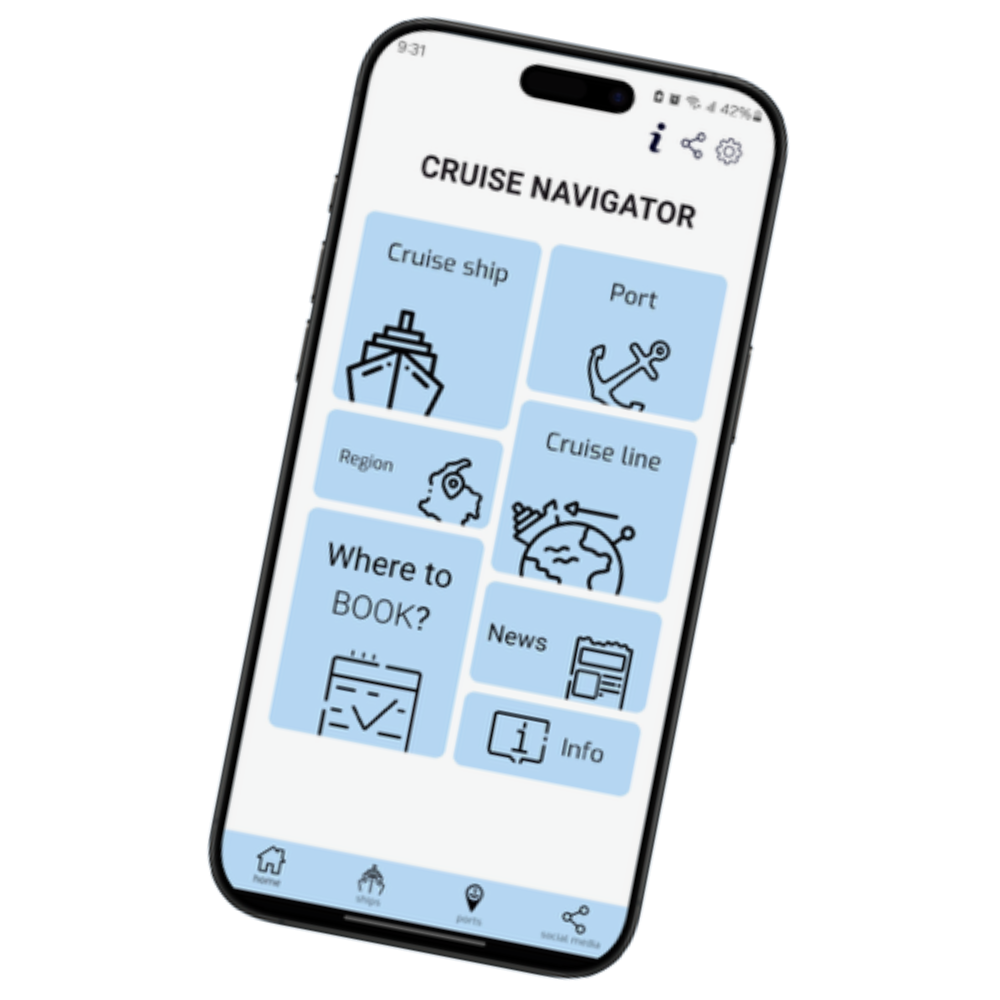Cruise Tips for Beginners: Your Ultimate First-Time Cruise Guide

The Ultimate Cruise Survival Guide for First-Time Cruisers
Cruising is a fantastic way to travel, but it’s a bit different from other types of vacations, so there are some top things about cruisers that every newbie should know. If you’re new to cruising, it can feel a little overwhelming, but don't worry. Once you learn the ropes, it's smooth sailing. Here are some of my top tips for new cruisers:
1. Choosing the Right Cruise
Picking the right cruise is super important. Different cruise lines offer different experiences. Some are great for families, others are luxurious, and some are budget-friendly. Before booking, think first about what kind of trip you want and choose a cruise that fits your style, and pick a cruise line that best fits your vibe.
If you're a first-time cruiser, I always recommend a shorter, 4-5 night cruise. Why? Because as much as I love cruising, I'll be the first to admit that this approach to travel isn't for everyone, and I know some folks who tried it and hated it. And nothing would be worse than being stuck on a cruise, hating life and wanting to get home, for 7+ days. A shorter cruise isn't just affordable, but it's a great way to test the waters.
2. Booking Your Cruise
Once you’ve chosen your cruise, it’s time to book! Then comes the question of how to find the best deal on a cruise and get the most bang for your buck. The good news is that cruising in general does just that, often providing great value with its all-inclusive nature, compared to traditional forms of land-based travel. Even still, deals can be had when booking a cruise.
My first tip to saving on a cruise is to book early or book late. Booking early (a year or more out) usually gives you access to lower prices and a wider selection of cabins, especially if you're eyeing a popular sailing or a newer ship. On the flip side, last-minute deals, like Holland America Line's Standby Program, can offer major discounts if your schedule is flexible. Cruise lines would rather fill a cabin at a discount than leave it empty.
For beginners, booking through a travel agent can be a smart move. Not only can they answer your questions and walk you through the entire process, which is helpful for a first-timer, but their services are generally provided at no cost (the cruise lines compensate them).
A great agent will also monitor your cruise fare after booking and notify you if the price drops. If you're still within the rebooking window, this could mean adjusting your reservation and scoring a refund or onboard credit for the price difference.
Related Video: 🎥 "Stop Booking Cruises Without Knowing These Essential Tips!"
3. Packing Smart
Once you've picked the perfect cruise, and booked it, you've got to start planning. To help with this, I have a free cruise Packing List & Planning Guide.
Packing for a cruise can be a bit of a balancing act since you'll need outfits for various activities and changing temperatures. For warm-weather itineraries like the Caribbean or Bahamas, pack casual clothing, swimwear, beachy clothes, and at least one outfit for formal or “elegant” nights if your cruise includes them. Even in tropical destinations, the ship’s indoor areas can be heavily air-conditioned, so a light sweater or jacket is a must.
For colder climates like Alaska, packing gets more complex. You'll need to plan for layering and bring bulkier items, such as coats, gloves, hats, and scarves. Prioritize warmth and waterproof gear, especially if you’re heading out on glacier excursions or whale-watching tours.
No matter the destination, it’s a good idea to bring your own toiletries. Many cruise lines only provide basic shampoo and body wash (conditioner and preferred brands are rarely included). Other essentials include sunscreen, any necessary medications, a non-surge-protected extension cord (surge-protected ones are prohibited), and a waterproof phone case for use on the beach or in rainy conditions.
And leave steamers and irons at home, because they’re not allowed on cruise ships for safety reasons. Instead, bring Downy Wrinkle-Release, or in a pinch, ladies can use a hair flat iron as a makeshift iron.
Not waiting until the last minute to start planning your packing list and strategy is important if you're taking your first cruise.
Related Article: 10 Essential Items to Pack for Your Cruise
4. Check-In Process
Online check-in is a crucial step that every cruiser must complete before boarding day. It’s similar to checking in for a flight, but for a cruise. You’ll go online to the cruise line's website (or app), log in, enter your personal information, upload your identification, set a payment method for onboard purchases, and select your boarding time.
Different cruise lines open check-in at different times before your sailing date. Here are a few examples:
-
Royal Caribbean: Opens 45 days before the cruise
-
Carnival: Opens 14 days before your cruise
-
Virgin Voyages: Opens 45 days before sailing
-
Norwegian: Typically opens around 21 days out
-
Disney Cruise Line: Opens 30 to 75 days out, depending on your Castaway Club status
Set a calendar reminder for the exact day your check-in opens so you can log in as early as possible. Early boarding time slots fill up quickly, so checking in right away increases your chances of getting a convenient arrival window. You’ll also want to complete this step early to avoid delays at the port.
After check-in, you’ll need to print two important things: your boarding documents and luggage tags. These will be available through your cruise line’s website or app. The boarding documents serve as your cruise ticket, including your boarding pass, boarding group, and other relevant details. The luggage tags should be attached to your suitcases before arriving at the port (assuming you plan to check your bags vs. self-carry).
When you arrive at the terminal, you'll want to have your printed documents, photo ID, and any required documents ready. You’ll undergo a security screening similar to TSA at the airport. From there, you’ll either wait to board or be guided directly onto the ship depending on your arrival time and group assignment.
Related Article: How to Handle Luggage When Getting on a Cruise Ship
5. Onboard Tips
Embarkation day is the official start of your cruise adventure. It’s exciting, but it can also feel a bit chaotic, especially if it’s your first time. Knowing what to expect can help make the process feel less overwhelming.
Depending on your boarding time, you may get on the ship before your stateroom is ready. Most cruise lines begin allowing access to staterooms around 1 PM or later, but this varies by line. For example:
-
Royal Caribbean and Carnival often open staterooms around 1-1:30 PM
-
Virgin Voyages is known for having staterooms ready slightly later in the afternoon
Until your room is ready, you’ll carry any luggage that you didn’t check at the port. That’s why it’s smart to bring a lightweight carry-on or backpack with your essentials: medications, sunscreen, a swimsuit if you plan to hit the pool early, and anything else you’ll need before accessing your room.
Because most passengers board around the same time and rooms aren’t open yet, common areas like the Lido buffet, main pool deck, and lounges can get very crowded. People are often walking around with their luggage, trying to find a spot to sit and grab lunch. If this feels a bit overwhelming, don’t worry... things calm down considerably once staterooms open and guests can unpack and spread out.
Must-Do's After You Board
Once you’re on board, start by getting your bearings. Here are a few smart moves for embarkation day:
-
Explore the ship: Walk around and get your bearings. Locate important areas like the main dining room, pool deck, fitness center, kids’ clubs, and specialty dining venues.
-
Book specialty dining: If your ship has specialty restaurants, the prime times for these can fill up fast. Book reservations on embarkation day if you haven’t already done so online in advance.
-
Download or check the daily schedule: You’ll receive a printed or digital “daily planner” with a list of onboard activities, shows, and events. This is your key to planning out the fun. Some cruise lines require reservations for certain shows so it's good to get to this early.
-
Complete the muster drill: All passengers are required to attend a safety drill, called a muster drill (not "mustard drill") before the ship departs. Most cruise lines now allow you to do this via their app or at a designated muster station shortly after boarding. It’s quick, easy, and mandatory.
-
Unpack and settle in: As soon as your stateroom is open, head to your cabin to unpack and organize. This is also a good time to meet your room steward if they stop by to introduce themselves.
6. Shore Excursions
Shore excursions are a major highlight of cruising. These are activities you do when the ship docks at different ports, and they range from beach days and city tours to adventurous outings like zip-lining, ATV tours, or snorkeling. It's best to book in advance, especially for popular options, to make sure you don’t miss out.
You can book excursions directly through the cruise line or independently through third-party providers. Cruise line tours are more convenient and come with the security of knowing the ship won’t leave without you if there’s a delay. Independent tours are often cheaper and more personal, but you’ll need to manage your time carefully, as the ship won’t wait if you’re late getting back.
In some ports, you don’t need to book anything at all. It can be just as fun to explore on your own, relax at a nearby beach, or take a walk around the local town. For example, Grand Turk and the cruise lines' private islands are great ports of call for easy, free beach days.
Check your itinerary and port details to decide what works best for each stop.
Related Article: Explore the Pros & Cons of Independent vs. Cruise Line Excursions
7. Health and Safety
Cruises are a great way to relax, but staying healthy onboard is key to enjoying your vacation. While all cruise ships have medical centers with trained staff, it’s always better to prevent problems before they start. I've gotten sick during a cruise, and had to seek treatment before, and believe me... it sucks.
If you're prone to motion sickness, consider bringing over-the-counter remedies like Dramamine or Scopolamine, but be aware that these don't work for everyone. Unfortunately, my body reacts badly to both of these, so I rely on natural options like Sea-Bands, Bonine and ginger. Be sure to test any medication at home first so you know how your body reacts, because you might be like me and have awful side effects. For the smoothest ride on a ship, book a cabin in the middle of the ship on a lower deck where movement is minimal.
Staying hydrated is another simple but crucial tip. The ship’s drinking water is safe, so bring a refillable water bottle to keep with you throughout the day. Dehydration can sneak up quickly in sunny ports or after indulging in a few cocktails.
Cleanliness counts too. Use hand sanitizer often, especially before meals and after using shared surfaces like railings or elevator buttons. When you first enter your stateroom, wipe down high-touch areas like door handles, remotes, and light switches with disinfecting wipes. It's a small step that can make a big difference in avoiding unwanted germs.
Finally, having travel insurance can offer peace of mind in the event of an unexpected illness or injury. Most cruise lines charge out-of-pocket for medical services onboard, and medical care on a ship or abroad may not be covered by your regular health insurance, and those costs can add up quickly.
Just ask this one guy whose on-board illness cost him $50,000.
Related: Guide to Travel Insurance for Cruisers: What's Covered & What's Not
8. Managing Your Expenses
9. Disembarkation Day
The last day of your cruise, and arguably the saddest, is called disembarkation, and it tends to come with a very early start. Most cruise lines require guests to be out of their staterooms by around 8 AM, sometimes earlier, and also off the ship entirely at a fairly early hour.
If you're using the cruise line’s luggage service, you’ll need to pack and place your suitcases outside your stateroom the night before disembarkation, tagged with the cruise line-provided tags, usually by 10 PM. The crew will collect them, and you’ll retrieve them in the terminal the next morning after leaving the ship.
Just remember to keep a carry-on bag with essentials like your passport or ID, travel documents, any medications, a phone charger, and a change of clothes. You won’t have access to your checked bags until you’re off the ship.
Alternatively, many cruisers choose to do self-assist disembarkation, meaning they carry all their luggage off the ship themselves. This is usually what I opt to do. The upside? You can be among the first to leave, skip the wait for luggage, and head directly home or to your next destination. The downside is you’ll need to manage your own bags through elevators, gangways, and stairs, which can be hectic during busy departure times and difficult for those with mobility limitations.
Before leaving your cabin for the final time, be sure to check your onboard account either through the cruise line’s app or at Guest Services. Because remember, once you’ve disembarked, it becomes much harder (if not nearly impossible) to resolve billing errors or disputes, so it's worth reviewing your charges the night before.
Getting off the ship so early can often mean figuring out what to do to kill time if you're flying back home and you have a late return flight. Here's what I recommend.
Disembarkation can feel rushed and a bit disorganized, especially on large ships, but with a little planning and patience, you’ll be on your way home and ready to book your next cruise.
Related Article: Best Tips for Handling Luggage During Cruise Disembarkation
BABY, LET'S CRUISE...
Let us help you plan the cruise (or trip) of a lifetime!
Subscribe to my Cruiseletter
Get juicy cruise info, insider tips, and FREE port guides, delivered straight to your inbox. Plus, you'll get my FREE Cruise Packing List & Planner, and I promise to never spam you.
By submitting this form, you're agreeing to receive emails from Professor Melissa. Don't worry, your info is safe with me. We'll never share or sell it. You can also unsubscribe at any time.






